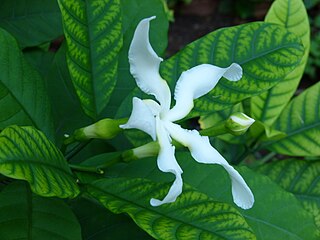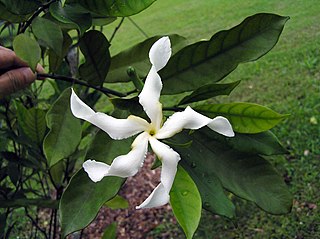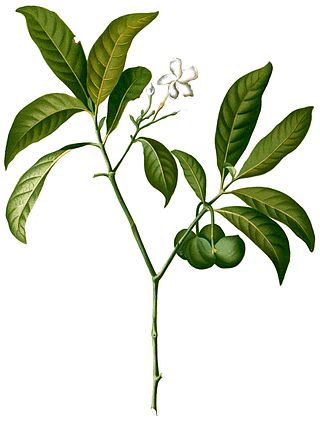
Apocynaceae is a family of flowering plants that includes trees, shrubs, herbs, stem succulents, and vines, commonly known as the dogbane family, because some taxa were used as dog poison Members of the family are native to the European, Asian, African, Australian, and American tropics or subtropics, with some temperate members. The former family Asclepiadaceae is considered a subfamily of Apocynaceae and contains 348 genera. A list of Apocynaceae genera may be found here.

Lactuca, commonly known as lettuce, is a genus of flowering plants in the family Asteraceae. The genus includes at least 50 species, distributed worldwide, but mainly in temperate Eurasia.

Tabernaemontana is a genus of flowering plants in the family Apocynaceae. It has a pan-tropical distribution, found in Asia, Africa, Australia, North America, South America, and a wide assortment of oceanic islands. These plants are evergreen shrubs and small trees growing to 1–15 m tall. The leaves are opposite, 3–25 cm long, with milky sap; hence it is one of the diverse plant genera commonly called "milkwood". The flowers are fragrant, white, 1–5 cm in diameter.
Tabernaemontana thurstonii is a species of plant in the family Apocynaceae. It is endemic to Fiji.
Tabernaemontana longipes is a tropical tree found in Colombia, Venezuela, Ecuador, Nicaragua, Panama, and Costa Rica. Its unusually shaped pods inspired the common name Dutchman's shoes. Its oval leaves are about 13 cm long and glabrous. The flowers are white.

Tabernaemontana divaricata, commonly called pinwheel flower, crape jasmine, East India rosebay, and Nero's crown, is an evergreen shrub or small tree native to South Asia, Southeast Asia and China. In zones where it is not hardy it is grown as a house/glasshouse plant for its attractive flowers and foliage. The stem exudes a milky latex when broken, whence comes the name milk flower
Tabernaemontana coffeoides is a species of flowering plant in the Apocynaceae family. It grows as a shrub or small tree up to 10 metres (33 ft) tall, with a trunk diameter of up to 20 centimetres (8 in). Its fragrant flowers feature white corolla lobes. Its habitat is on dunes or on rocks in dry forest, bush or savanna from sea level to 1,300 metres (4,300 ft) altitude. Local medicinal uses include for weight loss and to combat fatigue. Tabernaemontana coffeoides is native to Seychelles, the Comoros and Madagascar. It is also rich in pharmacologically interesting indole alkaloids.

Tabernaemontana crassa is a plant in the dogbane family Apocynaceae, native to tropical Africa.

Tabernaemontana elegans, the toad tree, is a shrub or small tree in the family Apocynaceae. It is native to eastern Africa.

Tabernaemontana pachysiphon grows as a shrub or small tree up to 15 metres (50 ft) tall, with a trunk diameter of up to 40 centimetres (16 in). Its fragrant flowers feature white to pale yellow corolla lobes. The fruit is green, almost spherical, up to 15 centimetres (6 in) in diameter. Its habitat is forests from sea level to 2,200 metres (7,200 ft) altitude. Its numerous local medicinal uses include as a styptic, and as a treatment for headache, hypertension and to relieve cramps. The species is native to tropical Africa.

Tabernaemontana ventricosa is a plant in the family Apocynaceae. It grows as a shrub or small tree up to 15 metres (50 ft) tall, with a trunk diameter of up to 30 centimetres (12 in) and has white sap. Leaves are paired and crowded near the ends of branches. They are oblong, leathery and a glossy dark green. Flowers are fragrant with white, somewhat twisted lobes, often with a pale yellow center and are set in small clusters at the ends of branches. The fruit is dark green, set in spreading pairs of ellipsoids or oval, beaked pods, up to 10 centimetres (4 in) in diameter. Its habitat is forests from sea level to 1,850 metres (6,000 ft) altitude. In Zimbabwe, it is usually found as part of the understorey of evergreen forests. Local medicinal uses include the treatment of wounds, fever and hypertension. The plant is native to tropical central and southern Africa.
Tabernaemontana stapfiana is a medium-sized tree in the family Apocynaceae. Its flowers feature white with yellow-throated corolla lobes. The fruit is fleshy grey-green, in pairs, each up to 20 centimetres (8 in) in diameter and weighing up to several kilograms. Its habitat is montane evergreen forests from 700–2,000 metres (2,300–6,600 ft) elevation. The plant is native to an area of Africa from Uganda south to Mozambique.

Tabernaemontana macrocarpa grows as a shrub or tree up to 30 metres (100 ft) tall, with a trunk diameter of up to 50 centimetres (20 in). The bark is yellowish brown, brown, grey-brown or grey. Its fragrant flowers feature combinations of cream, white and orange corolla lobes. The fruit is orange, with paired follicles, each up to 16 centimetres (6 in) in diameter. The specific epithet macrocarpa is from the Greek meaning "with large fruit". Its habitat is forests from sea level to 1,500 metres (5,000 ft) altitude. Tabernaemontana macrocarpa has been used as arrow poison. The species is native to Thailand and Malesia.

Tabernaemontana pandacaqui, known as windmill bush and banana bush, is a species of plant in the dogbane family Apocynaceae.
Tabernaemontana pauciflora is a species of plant in the family Apocynaceae.
Tabernaemontana rostrata grows as a shrub up to 2 metres (7 ft) tall. Its flowers feature a white corolla. The habitat is scrub or forest to 1,400 m (4,600 ft) altitude. The species is native to Bangladesh, Indo-China and Malesia.

Voacanga is a genus of plants in the family Apocynaceae found in Africa, Southeast Asia, New Guinea, and Australia. As of August 2013 the World Checklist of Selected Plant Families recognises 13 species:
- Voacanga africanaStapf ex Scott-Elliot - tropical W + C + E + S Africa
- Voacanga bracteataStapf - tropical W + C Africa
- Voacanga caudifloraStapf - tropical W Africa
- Voacanga chalotianaPierre ex Stapf - tropical C Africa
- Voacanga foetida(Blume) Rolfe -Java, Borneo, Sumatra, Philippines
- Voacanga globosa(Blanco) Merr. - Philippines
- Voacanga gracilipes(Miq.) Markgr. - Maluku
- Voacanga grandifolia(Miq.) Rolfe - Indonesia, Philippines, New Guinea, Queensland
- Voacanga havilandiiRidl. - Sarawak
- Voacanga megacarpaMerr. - Philippines
- Voacanga pachycerasLeeuwenb. - Zaïre
- Voacanga psilocalyxPierre ex Stapf - Nigeria, Cameroon, Gabon, Republic of Congo
- Voacanga thouarsiiRoem. & Schult. Madagascar; widespread from Cape Province to Sudan + Senegal
- Voacanga dichotoma = Tabernaemontana pachysiphon
- Voacanga plumeriifolia = Tabernaemontana macrocarpa
Tabernaemontana palustris is a tropical flowering plant species in the family Apocynaceae. It grows in the Amazon Basin of northern South America. The species epithet palustris is Latin for "of the marsh" and indicates its common habitat.
Tabernaemontana sananho is a tropical tree species in the family Apocynaceae known as lobo sanango. Lobo sanango grows in the Amazon Basin of northern South America.

Tabernaemontana dichotoma, commonly known as Eve's apple, is a plant in the dogbane family Apocynaceae. The specific epithet refers to the species' dichotomous branches.













